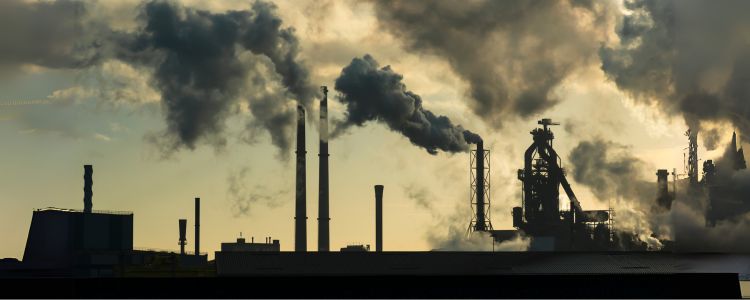
The Silent Threat: How Air Pollution Affects Your Well-being
- Dr Jeetesh Singh
- No Comments

Air pollution, a complex mixture of harmful particles and gases contaminating the atmosphere, has emerged as one of the most pressing challenges of the 21st century. Its insidious presence threatens human health and ecological balance, from smog-laden skies to toxic indoor environments. In India, where industrial growth and rapid urbanisation exacerbate pollution levels, addressing this silent threat is no longer optional—it’s imperative.
The health implications of air pollution extend far beyond temporary discomfort. Chronic exposure contributes to respiratory ailments, cardiovascular diseases, and compromised immunity, disproportionately affecting vulnerable populations like children and the elderly. However, amidst these challenges, holistic approaches like homoeopathy offer promising solutions. Schwabe India, a pioneer in homoeopathic medicine, advocates for integrative strategies to mitigate pollution’s effects, combining traditional wisdom with modern science.
This blog explores the multifaceted impact of air pollution on well-being, examines mitigation strategies, and highlights that homoeopathic remedies can fortify the body’s resilience against environmental stressors.
Table of Contents
ToggleUnderstanding Air Pollution
Types of Air Pollutants
1. Particulate Matter (PM)
Microscopic particles like PM2.5 and PM10, emitted from vehicles, industries, and construction sites, penetrate deep into the lungs, causing inflammation. Long-term exposure is linked to respiratory diseases, cardiovascular issues, and premature mortality. Their smaller size allows them to enter the bloodstream, exacerbating systemic health risks.
2. Nitrogen Dioxide (NO₂)
A reddish-brown gas from vehicular exhaust and industrial combustion, NO₂ irritates airways, worsening asthma, and bronchitis. It contributes to smog formation and acid rain. Prolonged exposure reduces lung function, particularly in children and the elderly, and increases susceptibility to respiratory infections.
3. Ozone (O₃)
Ground-level ozone is formed when pollutants react in sunlight, causing chest pain, coughing, and throat irritation. Unlike stratospheric ozone, it harms respiratory health, aggravating conditions like emphysema. High ozone levels correlate with increased hospitalisations for asthma and chronic lung diseases.
4. Sulphur Dioxide (SO₂)
By burning sulphur-containing fuels (coal, oil), SO₂ triggers wheezing, shortness of breath, and bronchitis. It transforms into sulfuric acid in the atmosphere, contributing to acid rain that damages ecosystems, crops, and infrastructure.
5. Carbon Monoxide (CO)
This odourless gas from incomplete combustion (vehicles, stoves) binds to haemoglobin, reducing oxygen delivery. Symptoms include dizziness, fatigue, and impaired cognition. Chronic exposure elevates heart disease risks, particularly in poorly ventilated spaces.
Also Read The Role of Homeopathy in India's Healthcare System
Sources of Air Pollution
1. Industrial Emissions
Factories, power plants, and refineries release hazardous pollutants, including sulphur dioxide (SO₂), nitrogen oxides (NOₓ), and heavy metals like lead and mercury. Industries such as steel, cement, and chemical manufacturing emit particulate matter (PM) and volatile organic compounds (VOCs), contaminating air and water. These emissions contribute to respiratory diseases, acid rain, and ecosystem damage, disproportionately affecting communities near industrial zones.
2. Vehicle Exhaust
Cars, trucks, and buses powered by diesel and petrol emit nitrogen dioxide (NO₂), carbon monoxide (CO), and fine particulate matter (PM2.5). Diesel engines are major contributors to urban smog, which is linked to lung cancer, asthma, and cardiovascular diseases. Traffic congestion amplifies exposure, while outdated emission standards in developing regions exacerbate health risks. Transitioning to electric vehicles can curb these pollutants.
3. Agricultural Activities
Crop residue burning, common in regions like Punjab and Haryana, releases PM2.5 and black carbon, worsening air quality. Fertilisers and livestock farming emit ammonia and methane, potent greenhouse gases. Pesticides contaminate air and soil, harming biodiversity and farmer health. Sustainable practices like organic farming and biogas generation can mitigate these impacts.
4. Household Pollutants
Biomass fuels (wood, dung) and kerosene used for cooking produce CO and PM2.5, causing indoor air pollution. Harsh cleaning agents release volatile organic compounds (VOCs), while mould and dust mites thrive in damp homes. Poor ventilation traps toxins, leading to chronic respiratory issues, especially in women and children. Adoption of clean stoves and natural cleaners can improve indoor air quality.
The Invisible Impact on Health
1. Respiratory Issues
Air pollution is a key driver of respiratory conditions. While bronchial asthma and COPD are widely documented, minor exposure can cause persistent coughing and reduced lung capacity. Homoeopathy for respiratory issues caused by air pollution focuses on alleviating inflammation and enhancing mucosal immunity. Schwabe India’s Drosera and Antimonium Tartaricum traditionally support bronchial health without suppressing natural defences.
2. Cardiovascular Effects
Pollutants like PM2.5 enter the bloodstream, triggering oxidative stress and arterial plaque formation. This elevates the risks of hypertension and arrhythmias. Homeopathic remedies for cardiovascular issues from air pollution, such as Crataegus and Arnica, may help maintain vascular elasticity and reduce oxidative damage.
3. Impact on Children and the Elderly
Children’s developing lungs and immune systems are highly susceptible, often leading to recurrent infections. The elderly face exacerbated conditions like fibrosis or chronic bronchitis. Homoeopathic strategies for reducing susceptibility to air pollution include Sambucus Nigra for pediatric respiratory support and Baryta Carbonica for age-related immunity enhancement.
Also Read Why BMI May Not Be a Fair Health Indicator
Environmental Consequences
Impact on Ecosystems
- Plants and Animals: Pollutants acidify soil and water, stunting crop growth and disrupting aquatic life.
- Natural Habitats: Biodiversity loss accelerates as species struggle to adapt to toxic environments.
Climate Change Implications
Air pollution and climate change share a vicious cycle. Black carbon from diesel emissions accelerates glacial melting while rising temperatures increase ozone formation. Global cooperation for air quality improvement, such as the National Clean Air Programme (NCAP), is critical to breaking this loop.
Mitigation and Solutions
1. Government Regulations
India’s Bharat Stage VI norms and push for electric vehicles reflect progress. However, stricter implementation of emission standards is needed.
2. Individual Actions
Simple steps—using public transport, adopting solar energy, and planting air-purifying plants—reduce personal carbon footprints.
3. Technological Advancements
Innovations like smog towers and low-cost sensors empower cities to monitor and combat pollution.
4. Homeopathy for Air Pollution
Homeopathy offers natural remedies for air pollution effects by enhancing the body’s detoxification pathways. Schwabe India’s Nux Vomica aids in detoxifying from pollutants, while Arsenicum Album combats oxidative stress. These homoeopathic approaches to lung health focus on restoring balance rather than merely suppressing symptoms.
How Can You Protect Yourself?
1. Use N95 Masks
N95 respirators are critical during high AQI days, filtering 95% of PM2.5 and PM10 particles. Unlike cloth masks, they create a seal to block pollutants like dust, smoke, and allergens. Prolonged exposure without protection can worsen respiratory conditions, making them indispensable for outdoor workers, cyclists, and vulnerable groups. Ensure proper fit and replace masks when soiled or damaged.
2. Indoor Air Purifiers
High-efficiency particulate air (HEPA) purifiers trap PM2.5, pollen, and pet dander, reducing indoor pollution by up to 99%. Activated carbon filters absorb volatile organic compounds (VOCs) from paints and cleaners. For optimal efficacy, place units near windows or high-traffic areas. Regular filter maintenance ensures performance, safeguarding against asthma triggers and long-term lung damage.
3. Dietary Antioxidants
Vitamins C (citrus, bell peppers) and E (nuts, spinach) neutralise free radicals generated by pollutants, reducing oxidative stress. Omega-3 fatty acids (fish, flaxseeds) combat inflammation in airways and blood vessels. Include turmeric (curcumin) and green tea (polyphenols) for enhanced detoxification. A balanced diet strengthens immunity, mitigating air pollution effects on skin and organs.
4. Homoeopathic Support
Schwabe India’s Bicarbonate Compound aids systemic detoxification by enhancing the body’s natural elimination of pollutants. Kali Sulphuricum addresses skin issues caused by pollution, such as rashes and dryness, by restoring epidermal balance. These remedies, part of holistic homoeopathic strategies, complement lifestyle changes to reduce susceptibility to air pollution.
Also Read Top 10 Surprising Reasons Your Child Can't Sleep
Schwabe India: Your Partner in Combating Air Pollution’s Health Toll
Air pollution’s health impact and environmental consequences demand urgent, collective action. While policy reforms and green technologies pave the way, integrating homoeopathic solutions for asthma in polluted environments and other conditions can provide personalised, side-effect-free relief. Schwabe India’s commitment to environmental health and homoeopathy underscores the synergy between sustainable practices and holistic wellness.
Take Charge Today: Explore Schwabe India’s homeopathic remedies for lung detoxification and immune support.





























